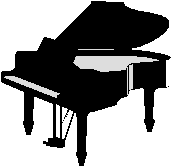
 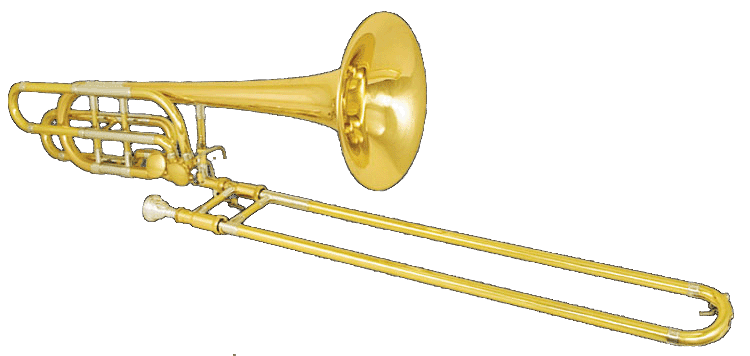
 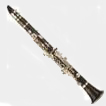  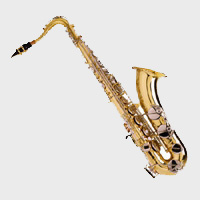 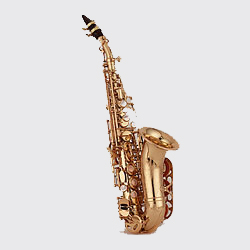
Concert Band Instrumentation
Play in a community or concert
band? Have you ever wondered what a full- concert band, with all the
instruments, is supposed to be like? This page will give you an idea.
Instruments in a Concert Band
There are many different
instruments and sections that make up a concert band.
Flutes & Piccolos
![[picture of piccolo]](piccolo_s.gif)
|
Piccolo (and
also the Db Piccolo)
The piccolo is a special kind of flute that is pitched one octive
higher. The musicians who play piccolo usually also play flute. Most
pieces call for only one piccolo player, but we have encountered music
that calls for two piccolos. The piccolo is extremely difficult to
play, and hard to keep in tune while playing...which explains so many
jokes about piccolo players.
Db Piccolo
Another special kind of piccolo, called a Db Piccolo (aka Military
Piccolo), is sometimes used instead of the regular piccolo. Rarely
used nowadays, the Db piccolo was commonly used in the first half of
the 20th century. The Db piccolo is pitched a semi-tone higher than a
regular piccolo. It used for some pieces that are played in keys with
a lot of sharps or flats. The Db Piccolo is pitched in the key of Db
(unlike the regular Piccolo which is in "concert pitch") which makes
these pieces eaisier to play. One well known piece where this is the
case is the Amercian march "The Stars and Stripes Forever", which we
don't play very often because we are Canadians. |
![[picture of flute]](flute_s.gif)
|
Flute
The flute has a very clear and flowing sound to it. Most music has 2
or 3 flute parts. The flute alone cannot produce very much volume, so
a lot of players are required in the flute section. A full-sized band
will usually have 8-12 flute players.
The word flute covers a
wide range of woodwind instruments, in which sound is produced by
directing air across the edge of a hole. Along with the flute which is
pictured here the family includes the piccolo, the fife, and panpipes.
Most flutes are made of metal, usually silver; modern flutes are only
occasionally made of wood. The flute is used in orchestras, wind
bands, and jazz bands to give a bright, silvery sound. It is played by
blowing across the blowhole. Apart from the piccolo, the flute is the
only instrument in the orchestra that is played in this way. The pitch
range is three octaves, it is keyed in concert-pitch, and it measures
approximately 26 inches long and just under 1 inch in diameter. There
are other larger flutes called the alto flute and the bass flute, but
they are very seldom used in concert bands, and are rarely used in
orchestras.
Eb Flute
At one time there was another kind of flute pitched in Eb, called the
Eb Flute, that was often used in bands. However, the use of this
instrument fell out of favour by about the 1930s. Pitched between the
piccolo and the flute, it was sometimes used instead of the piccolo in
band arrangments where the high range of the piccolo was not needed.
If an an older piece of music has a part for Eb Flute it would exist
as a "Eb Flute/Eb Clarinet" part which meant it could be played by
either instrument. Eb Flutes are now long-gone and no longer used, but
Eb clarinets are still part modern band.
Fact: The flute's haunting
sound has long been linked with magical properties, as in Mozart's
opera, "The Magic Flute", or in the Pied-Piper legend.
|
Double Reeds
![[picture of oboe]](oboe1_s.gif)
|
Oboe
The oboe has a piercing sound that cuts across the entire band and has
many beautiful solos in many pieces. The band usually has both a first
and a second oboe player. The pitch of the oboe is usually used to
tune the band.
The oboe consists of a
conical keyed tube played with a double reed. The piercing sound,
characteristic of oboe-type instruments, is particularly suitable for
outdoor use. The oboe is the smallest of the orchestral, double reed
instruments. Its expressive sound is often used to play sad or
emotional melodies. Because air is forced at high pressure into the
tiny reed, stale air can gather in the lungs, making you feel faint if
the air is not expelled quickly. Because of this, it is often said to
be a very difficult instrument to play. The pitch range of the oboe is
two-and-a-half octaves, and it is made of wood. The oboe plays in
concert-pitch. The oboe is just under 24 inches long.
Fact: The oboe was one of
the first woodwind instruments to have a regular place in the
classical orchestra. When the modern concert band began to develop,
bands inherited the oboe as part of their instrumentation. Because its
pitch does not vary much with temperature, the oboe sounds the
concert-A note, to which all other instruments in the orchestra or
band adjust their tuning. |
![[picture of an english horn]](englishhorn_s.jpg)
|
English Horn
(aka Cor Anglais) - rare and we don't have access to one
The english horn is an incredibly strange and mysterious sounding
instrument. It has a very haunting and mello tone, and sort of looks
like a big oboe with a pear-shaped bulb on the end. The English horn
is pitched in F, which is lower than the oboe. The english horn is
usually played by an oboe player that happens to own and play both
instruments. |
![[picture of bassoon]](bassoon_s.jpg)
|
Bassoon
The bassoon plays an important part as one of the inner voices of the
band. Falling in between the upper-woodwinds and the bass section, the
bassoon usually has intricate harmony parts and the odd exposed
section where the unique timbre of the bassoon sound can be easily
heard. Most music has both a first and a second bassoon part. It
always seems to be a constant struggle to find bassoonists to play in
the band - there simply aren't many of them around.
Bassoons are the largest
commonly used double-reed instruments in the band. They have double
reeds and consist of several sections or joints of wood. Playing the
bassoon involves great effort to overcome its considerable weight, and
agility to control its awkward keywork system. Thre are actually two
complete different types of bassoons, which differ by their kework-systems:
there is the German (or "heckel") key system, and what is known as the
French (or "ring") key system. Heckel System (aka German keywork)
bassoons are the the ones used in the band. In North America, the
Heckel system bassoon is the most common kind. The pitch range of the
bassoon is three-and-a-half octaves; it is usually made of maple or
rosewood, with a metal bocal. The bassoon plays in concert-pitch. The
size is 4 ft. 4 in. long; total length of unwound tube is 8 ft. 3 in.
Fact: The Italians call
the bassoon a "fagotto", meaning "bunch of firewood". The poet,
Sacheverell Sitwell likened the bassoon's deep, dark tones to the
sound of "a sea-god speaking." |
![[picture of a contrabassoon]](amati-contrabassoon_s.jpg)
|
Contrabassoon - very rare and very seldom used
Sometimes called the Double-Bassoon, contrabassoons are huge. They are
twice as big as a bassoon and sound an octave lower. They are very
rare and hidieously expensive. In the hands of the best musicians, the
contrabassoon organlike tone rings through the orchestra, adding
richness and weight to chords. Contrabassoons are almost never found
in bands, but can sometimes be heard in symphony orchestras. The
bassoon's tubular body is divided into four sections, and doubles back
on itself to make it more manageable to play.
Some very old
orchestral-transcriptions will have a part for one; and modern
repertoire only very rarely calls for one and even then it is
"optional". For the most part in modern band music , the role the
contrabassoon played is now handled by the contrabass clarinet. If we
encounter a piece of music with a contrabassoon part, we will often
leave it unplayed or have our contrabass clarinet player play the
part. Even in the symphony orchestra, which is where they originated
from, contrabassoons are not called for very often. |
|
![[picture of a contrabassoon]](contrabass-sarrusophone_small.gif)
|
Contrabass
Sarrusophone - very, very rare and almost unheard of
Now this is a strange instrument! The contrabass sarrusophone is a
huge double-reed instrument constructed out of metal. It has a sound
somewhat between that of a bass saxophone and a bassoon. It covers the
same range as the contrabassoon. Contrabass sarrusphone parts do not
exist in band music, but the instrument is sometimes used instead of a
contrabassoon. Many say it actually sounds much nicer than a
contrabassoon. However, there is only one concert band that I know of
in North America that actually has one of these - it is played by a
fellow named Grant Green in
the San Jose Wind Symphony. Rumour has it that the Indianapolis
Concert Band has one as well. Apparently, sarrusophones are still
quite popular in military bands in Italy. In Italy, you will also
sometimes see the other members of the sarrusphone family: the
soprano, alto, tenor and various embodiments of the bass sarrusphone.
The sarrusophone was developed by Gautrot in the mid 1800s to compete
with the saxophone; it fell out of favour by about the late 1920s. It
is named after the famous French bandmaster Pierre-Auguste Sarrus
(1813-1876). |
Clarinets
![[picture of Eb clarinet]](Eb-clarinet_s.gif)
|
Eb Clarinet
The Eb clarinet is a funny little solo instrument sometimes used in
band music. The melody played by this instrument is usally a higher
version of the main melody or a completely different counter-melody.
It's high range gives the clarinet section of the full sound. There is
usually only ever one Eb clarinet, if there is one at all, for a
piece. Some older music will sometimes call for two Eb clarinets, but
we usually have someone transpose the 2nd Eb part onto regular
clarinet. The Eb clarinet has the same range as a regular clarinet but
is pitched in the higher key of Eb. Very few bands have an Eb
clarinet, and for good reason! Eb clarinets are very hard to play in
tune - a bad Eb clarinet player can make even the best band sound
positively dreadful. But played properly and in tune it is a gem!
|
![[picture of Bb clarinet]](clarinet_s.gif)
|
Bb Clarinet
(aka Regular Clarinet)
The Bb clarinet is is one of the mainstays of the concert band.
Performing the same role that the string section would in an
orchestra, clarinets provide much of the body of sound in the band.
There are usually at least three Bb clarinet parts and a solo part
spread amongst 10-15 clarinetists. If there is no oboe, the pitch of a
clarinet will be used to tune the band.
The clarinet consists of a
cylindrical tube whose mouthpiece has a single, vibrating reed. One of
the best known is the Bb clarinet with French standard Boehm fingering
system. (There are also a number of different key/fingering systems
such as the Oehler, Albert, German and other variations but they are
seldom, if ever, used in North America.) The clarinet is one of the
most versatile of all modern instruments. It has a very wide range of
notes (three-and-a-half octaves), and you can hear its pure, clear
sound in orchestras, military bands, and jazz groups. Construction is
usually of African blackwood or moulded plastic, and it is just over
26 inches long. The clarinet family also includes the little Eb
clarinet, bass clarinet and the rare contrabass clarinet, along with
many others. It has a breathy, almost hollow tone - popular with jazz
saxophone players who often use it as a second instrument.
Fact: Until the 19th
century, the clarinet was played with the mouthpiece the opposite way
up to the way it is played today. |
![[picture of alto clarinet]](alto-clarinet_s.gif)
|
Alto
Clarinet
The alto clarinet is an Eb clarinet pitched between the regular Bb
clarinet and bass clarinet. It bridges the tonal gap between the 3rd
clarinet and the bass clarinet. The alto clarinet has the same range
as regular clarinet except that plays in the key of Eb, and will ofen
have an extra low Eb key. The alto clarinet is relatively rare in most
North American concert bands: there are always parts for the
instrument but alto clarinet players are generally hard to find.
|
![[picture of bass clarinet]](bass-clarinet_s.gif) |
Bass
Clarinet
The bass clarinet has a dark sound that usually accompanies the bass
section but often can be heard by itself with a counter melody. The
bass clarinet has the same range as regular clarinet but plays in the
key of Bb one octive lower. Bass clarinets usually have an extra low
Eb key. Some bass clarinets will have their range extended down to a
low C by way of extra keys and being much longer, however these
instruments are extremely expensive and quite rare. The band will
usually have one or two bass clarinets. |
![[picture of contra-alto clarinet]](contra-alto-clarinet_s.gif)
|
Contra-Alto
Clarinet (aka Eb Contrabass Clarinet)
A really big clarinet that is pitched below the bass clarinet, that
plays very low bass parts. The contra-alto clarinet is pitched one
octave below the alto clarinet, and thus plays in the key of EEb.
Another name for the contra-alto clarinet is the Eb Contrabass
Clarinet, and both terms are used interchangably. Contra-alto
clarinets are usually contructed of either wood or resonite, and are
sometimes made of metal. Most contra-alto clarinets are a straight
tube that measures a little over 4 feet high, but looped ("paperclip")
instruments are also occasionally constructed of metal. This EEb
clarinet also has the unique property of being able to read and
sight-transpose BBb tuba parts very easily: by reading the bass cleff
as if it was treble clef and adding 3 sharps. |
![[picture of contra-bass clarinet]](contra-bass-clarinet_s.jpg)
|
Contrabass
Clarinet - rare and we don't have access to one
A very, very big clarinet. It often doubles the tuba/string-bass parts
or has its own unique variation on those parts. The one pictured on
the left is a looped ("paperclip") model constructed out of
nickel-silver. Contra basses, like the contra-alto are so big that the
tubing has to "loop back on itself". These instruments can be
constructed as big long straight body section or in looped form (as in
the picture). Contra bass clarinets are pitched in BBb, two octaves
below the regular Bb clarinet, and often have an extended low range
down to Eb, D or C. Contrabass clarinets are also sometimes called
Pedal Clarinets, term that is sometimes used in England and other
European countries. The name Pedal Clarinet, comes from the fact they
play so low they can be used to emmulate the deep "pedal notes" you
would play on a pipe organ using your feet. To get an idea how big
this instrument is, the straight model in the picture link can be
played from the standing position. |
Saxophones
![[picture of soprano sax]](soprano_sax_s.gif)
|
Soprano Sax
The highest pitched of the conventional saxophones. It either has its
own melody part or doubles the tenor sax part. The soprano sax is
pitched in Bb and has a regular range of approxmately two and a half
octaves. Not a lot of concert band music uses one. |
![[picture of alto sax]](alto_sax_s.gif)
|
Alto Sax
The first and second alto sax parts carry the melody when the sax
section is playing. They are used extensively when the band is playing
jazz, movie music and swing. The alto sax is pitched in Eb and has a
range of approximately two and a half octaves. There are usually two
to four players on alto sax. |
![[picture of tenor sax]](tenor_sax_s.gif)
|
Tenor Sax
The tenor sax adds body to the sound of the sax section by filling in
the inner voices. It also plays many harmonies and melodies in more
jazzy and showy tunes. The tenor is pitched lower than the alto, in
the key of Bb and has the same two and half octave range. There is
usually just one tenor part and it is is often doubled or tripled.
|
![[picture of baritone sax]](baritone_sax_s.gif)
|
Baritone Sax
The baritone sax is usually the largest sax that plays in the band. It
plays the bass line for the sax section and often gets a solo or two
in jazz tunes. The baritone sax is pitched in EEb, has a range two and
a half octaves, and will sometimes have an extra key to allow it to
play down to a low A instead of just a Bb. |
![[picture of baritone sax]](bass-sax_selmer_s.gif)
|
Bass Sax -
rare and seldom used
The bass sax is an extremely rare saxophone. Some old band music has
parts for it. It usually strengthens tuba lines. Modern band music
almost never calls for a bass sax.
However, a lot of the
classic band repertoire from the first part of the 20th century will
often have a part for bass saxophone. Composers that liked to score
for bass sax include: Holst, Vaughn-Williams, Grainger, Gershwin, and
many others. Very little music scored after the 1950 includes a bass
sax part. Since most bands don't have a bass sax, they usually leave
the part unplayed since it will often be doubled by another instrument
as well. The bass sax is pitched in BBb, has a range two and a half
octaves. The bass saxophone is an instrument that is huge, heavy,
costly and to not to mention extremely rare. Bass saxes measure almost
five feet high (and the tubing usally loops back on itself as well!).
|
Brass
![[picture of trumpet]](trumpet_s.gif)
|
Trumpet
The trumpet is one of the lead instruments in the band. Melody is is
carried chiefly by the 1st trumpet, with the 2nd and 3rd trumpet parts
establising the section's thick brassy sound. The trumpet has a very
cylindrical bore that gives it a very bright sound. A band usally will
have 6 or more trumpets.
A trumpet consists of a
narrow tube with a cup-shaped mouthpiece at one end and a flared bell
at the other. The trumpet is used to play all kinds of music ranging
from South American ballads to flashy fanfares to classical orchestral
pieces. Blazing fanfares and moody mellowness are all characteristic
trumpet sounds. The pitch range of the trumpet is
two-and-three-quarter octaves, and it is usually made of brass and
covered with lacquer. Trumpets pitched in Bb are used in the band. It
is about 18 inches long; total length of unwound tube is 4 ft. 6 in.
Fact: Trumpets are at
least 3,500 years old: silver and bronze trumpets were among the
objects found in the tomb of the Pharaoh Tutankhamen in Egypt.
|
![[picture of cornet]](cornet_s.gif)
|
Cornet
The cornet is very similar to the trumpet, except that is has a more
conical bore that gives it a softer sound. Most pieces have a
combination of trumpet and cornet parts. All of our the trumpet and
cornet players can play both trumpet or cornet. Cornets are also
pitched in Bb and have a usual range of two-and-three-quarter octaves.
|
![picture of flugel horn]](flugel-horn_s.gif)
|
Flugel Horn
- seldom used
A flugel horn is sort of like a very large bore version of the
trumpet. Due to its shape, the flugel horn has its own very mello
sound that is very well suited for jazz solos. It is not used very
often in the band and, when it is used, it is only for a solo in a
show or jazz tune. The flugel horn is also pitched in Bb and has the
same range as a trumpet. |
![[picture of trombone]](trombone_s.gif)
|
Trombone
The trombones are a large instrument that features a slide instead of
valves. The cylindrical shape of the tubing gives them a very bright
tone. They are used for low brassy sections of music and help with the
inner voices and bass section of the band. There are usually 3 or 4
trombone parts that are often doubled. The trombone used in the band
is actually the "tenor trombone"; there are actually other different
sized trombones in the trombone family but these others (except for
the bass trombone) are never used in concert bands and are quite rare.
Trombones are brass
instruments with long, cylindrical tubes, flared bells, and cup-shaped
mouthpieces. Most trombones have a slide that the player uses to alter
the length of the tube and change the pitch, but some have valves.
Some trombones will also have some rotary valves in addition to the
slide, to make the instrument more flexible. In the orchestras, it
often represents the voice of doom and danger with its loud, deep,
bass sound that can slide menacingly from one note to the next. The
trombone can also play softly: its warm tone often features in jazz
bands and brass groups. The pitch range is two-and-a-half octaves,
plays in concert-pitch and the tube length is usually 9 feet.
Fact: In the 17th and 18th
century, trombones were used in operas for supernatural scenes. In
Mozart's opera "Don Giovanni", the trombone is used to accompany the
statue of the dead Commendatore. Also, Glen Miller, of big band fame,
was a trombone player. |
![[picture of trombone]](bass-trombone_s.gif)
|
Bass
Trombone
What a bass trombone exactly is, is up for debate, as there is no
consensus on what exactly a bass trombone is. However one thing that
people seem to be able to agree upon is that a bass trombone is very
large trombone with one or more triggers (valves). The large bore and
big bell gives the bass trombone a deeper sound than regular trombone
and is usually used on the 3rd and/or 4th trombone part. It also plays
in concert-pitch. A band will usually have one or two bass trombones.
|
Horns
![[picture of horn]](french-horn_s.gif)
|
French Horn
The french horn has a rich full sound that is used for melodic
passages as well for providing accompaniment to other sections of the
band. There are usually 3 or 4 differnt horn parts that are usally
played with one-on-a-part.
A horn is an instrument
consisting of a mouthpiece and a long tube that widens out to the
bell. Along with the French horn pictured here the horn family
includes such oddities as the Wagner Tuba and the Shofar (which you
would never see in a concert band). The French horn is a brass
instrument built in a circle, with a large bell that is held down by
the player's side. It is also the only brass instrument in which the
valves are operated with the left hand -- all other brass instruments
are operated with the right hand. Its rich, velvety sound is heard
mostly in orchestras and bands. The French horn first came into the
orchestra in pairs to portray the sound of hunting horns but is now
used in music of all sorts. The pitch range is three-and-a-half
octaves, and its length is variable. The total length of unwound tube
is between 9 and 12 feet. French horns are tranposing instruments and
usually play in the key of F.
Fact: Did you know that
because it is difficult for a player to be able to master both the
extreme high and the extreme low notes, professional players often
specialize in one or other range? |
Bass Brass
![[picture of euphonium]](baritone_s.gif)
|
Euphonium (aka
Baritone)
The Euphonium is like a small tuba, but is considered the solo
instrument of the bass section. You can easily hear the euphonium
quite clearly in most marches and military music. The euphonium can
either play as a Bb instrument or as a bass clef concert-pitch
instrument.
Baritone
The instrument pictured on the left is actually a baritone. There is a
difference between a baritone and a euphonium. Both are pitched the
same and have the range, but a baritone has a very narrow bell with
cylindrical tubing, while a euphonium has a large bell with conical
tubing. The result is that while a baritone has a very bright sound, a
euphonium will have a more mello dark timbre. Technicaly, for a
concert band we should only use euphoniums and not baritones. Good
bands try, if at all possible, to only use euphoniums, but sometimes
the only instrument a player owns in a baritone. |
![[picture of an Eb tuba]](Eb-tuba_small.jpg)
|
Eb Tuba -
rare but the band owns one, we'd like someone to come and play it
The Eb tuba is more of an odd-ball these days, than a common
instrument. Still sometimes heard in brass bands, the Eb tuba has fell
out of favour in North America in the last 50 years or so. Eb Tubas
are still fequently used in europe, as it is actually a flexible
instrument than the usual BBb tuba. Originally quite common around the
turn of the century up until WWII, the Eb tuba is a small tuba pitched
mid-way between the euphonium and the regular (BBb) tuba. It usually
plays the same line as the tuba, but often an octave higher instead.
Most Eb tubas only have 3 valves, but some have 4 valves which allow
the to play just as low as a regular BBb tuba. (The 4th valve allows
the player make the instrument as long as a regular tuba for those
really low notes.) As with all bass brass, parts for Eb tuba are
written in concert pitch and the player must sight-tranpsose
themselves as they play--this is the contributes to one of the major
reasons the Eb tuba fell out of favour. Most tuba players learn on a
BBb tuba, and are hestitant to have to learn the different
tranposition needed for the Eb tuba. |
![[picture of tuba]](tuba_s.gif)
|
Tuba
The giant tuba is the primary instrument that makes up the bass
section of the band. Its deep sounding low notes provide the
foundation for the band's sound.
The tuba is the largest
and deepest member of the brass family. It consists of a huge brass
tube that bends or folds around, beginning at the mouthpiece and
ending in a large flared bell. Other bass instruments in the brass
family are the sousaphone and euphonium. The tuba is actually a
gigantic bugle which is held upright. Even though it is bulky and
plays in a low register, you can play very fast notes or light and
airy tunes on the tuba. Tubas play in concert bands, are often used in
orchestras and are popular in marching bands. The tube of the pitched
in the key of BBb, measures over 18 feet when uncoiled.
Fact:The tuba player in
Canada's famous brass ensemble, the "The Canadian Brass", is such a
nimble player that he can play "The Flight of the Bumblebee" at full
speed on the tuba without even breaking a sweat. |
String Bass
![[picture of string bass]](string-bass_s.jpg)
|
String Bass
The string bass, also called the double bass, is one of the bass
instruments for band. It will often play pizzicato in lightly scored
musical passages, for a very light effect.
The double bass is the
largest member of the violin family. Its deep pitch can be heard
playing the bass line in orchestras, jazz bands, and folk music
ensembles all over the world. To produce music, the double bass can be
bowed or plucked. When used in jazz, it is mostly plucked. The double
bass has a pitch range of more than two-and-a-half octaves; it is made
of wood with steel strings. The double bass is usually over 6 ft.
high. Like most members of the violin family it is pitched in
concert-pitch.
Fact: The standard double
bass is already one of the biggest instruments, but the largest one
that ever existed was almost 16 ft. tall. It was constructed by Paul
de Wit as part of the celebrations for the Cincinnati Music Festival
in 1889. |
![[picture of string bass]](electric-bass_s.gif)
|
Electric
Bass
The string bass player will sometimes play electric bass instead of
the string bass, for some jazzier numbers. |
Percussion
![[picture of drum set]](drum-set_s.jpg)
|
Drum Set
One of the most versitile of the percussion instruments. A drum set
usually consists of a bass drum, snare drum, 2 toms, a floor tom, a
ride cymbal, a crash cymbal and a hi-hat (which is a pedal operated
device consisting of two small cymbals on a stand that is also hit
with a stick). It is used for almost all of our pieces of music and,
especially if the number of avaiable percussionists is minimal because
it can emulate the sounds of most of the other percussion instruments.
The drum set is almost always used when playing jazz, latin, pop and
rock music. |
![[picture of snare drum]](snare-drum_s.jpg)
|
Snare Drum
This shallow, cylindrical drum produces a sound that is very
distinctive to the drum (higher in pitch than the bass drum). The
snares, which are bands of metal wires, are pulled across the bottom
head of the drum. This produces a buzzing or snapping sound when the
drum is struck using a variety of techniques. |
![[picture of cymbals]](cymbals_s.gif)
|
Cymbals
Cymbals are metal disks that are clashed together a sound. They come
in a variety of sizes: from the delicate, eastern finger cymbals, to
the large and deafening orchestral cymbals. Cymbals are actually thin
bronze disks, held at the centre so that the edges are free to
vibrate. Cymbals can produce a surprising range of effects: some
soft and delicate, others loud and harsh. They are used in almost
every type of music, from formal orchestral music to heavy rock, where
they form part of a drum kit. When played singlely or as part of a
drum kit they are mounted on a stand and can be struck, scraped or
rolled with mallets to produec a multitude of effects. Diameters
usually range from 12 to 26 inches. There are many different shapes
and sizes of cymbals, but all of them resemble a thin brass disk that
is held/attached in the middle. Pictured on the left are a pair of
Crash Cymbals, are played by grasping one in each hand and then
hitting the cymbals together.
Fact: Did you know that if
air is trapped between the crash cymbals as they are "clashed", the
sound will be choked. |

|
? Suspended
Cymbal
The suspended cymbal is a large cymbal mounted on a stand which is
played by rolling using two soft yarn mallets. The result is a
shimmering brassy sound that is used to emphasize and add body to
musical passages. |
![[picture of bells]](bells_s.gif)
|
Bells (aka
Orchestra Bells)
The orchestra bells are a series of metal bars that are struck with a
mallet. They have a very high and pure sound. The bells are considered
part of the melodic percussion since a melody can be played on them.
|
![[picture of xylophone]](xylophone_s.gif)
|
Xylophone
The xylophone consists of two rows of wooden bars, arranged like a
piano keyboard. When you strike the bars with hard beaters, the
xylophone gives a bright and penetrating sound; soft beaters make the
sound more mellow. The xylophone's ringing notes make it a colourful
addition to the percussion section of a band or orchestra, but it can
also sound eerie and chilling. The pitch range of the xylophone is
from three-and-a-half to four octaves. Its size is variable ( around 6
ft. long and 3 ft. tall ).
Fact: The great Romantic
German composer Felix Mendelssohn stated that the xylophone was "the
most perfect instrument". |

|
Vibraphone
The vibraphone has a very airy and vibrato-like sound due to a
mechanic set of rotors that affect how the resonance tubes below the
bars carry the sound. |

|
Marimba
The marimba is similar in construction to the xylophone, but it has
larger bars and larger resonance tubes on the bottom. As a result the
marimba has a much warmer and resonate tone than the xylophone.
Marimbas usually span a pitch range of 4-1/3 octaves, and 5 octave "grande
marimbas" are often used. The marimba is not used very often in
concert band music, but when it is used it has a wonderful effect on
the overall sound of the band. |
![[picture of instruments]](handinst_s.gif)
|
"Toys" and
other Auxilliary Percussion
Percussion instruments include anything that you hit, scrap or tap to
accompany the band. These instruments include claves, tamboreen, bongo
drums, cabbassa, wood block, cow bell, guiro, maracas, wood block,
etc.. Also included are "Toys" such as slide whistle, duck call,
shaker-balls and even an air-raid siren sometimes. |
![[picture of a triangle]](triangle_s.jpg)
|
Triangle
The sound of the triangle is the soft "ding" that you will sometimes
here during some passages. |
|
![[picture of temple blocks]](temple-blocks_s.jpg)
|
Temple
Blocks
The temple blocks have their own unique "popping" sound that is often
used in Asian-inspired music. |
|
![[picture of timbales]](timbales.jpg)
|
Timbales
Timbales are a set of metal-bodied drums with a skin on one side,
usually measuring 13" and 14" in diameter. They are only used in
Latin-style music and thus are not often used in the band.
Timbales are percussion
instruments from Latin America that consist of a pair of shallow,
single-headed cylindrical drums tuned to different pitches and played
with thin sticks. Hitting the metal shell with a steady beat is a
common technique. In relation to other Latin American drums, the
timbales sound higher than congas, but lower than bongos.
|
|
![[picture of conga drums]](conga-drums_s.jpg)
|
Conga Drums
(aka Congas)
The conga drums are a large pair of drums that are played used one's
hands. They are usually mounted on a stand and each measure about 13"
in diameter and about 3 feet high. They are only used for latin-style
music, as well as some more modern band repertoire, and are thus
seldom used. |
![[picture of chimes]](chimes2_s.gif)
|
Chimes (aka
Tubular Bells)
Designed to emmulate the sounds of church bells, the chimes give
ringing tones that can be heard over the entire ensemble. They are
often used during slow lyrical passages in chorals and in rythmically
complex movements where the band is working towards a finale. Our set
of chimes is over 7 feet tall and are played using a pair of small
hammers. |
![[picture of a gong]](tam-tam_s.gif) |
Gong
The gong is very similar to the Tam-Tam, except that it has a large
bump in the middle that gives is a rounder, cooler sound.
|
![[picture of tam tam]](tam-tam_s.gif) |
Tam-Tam
The tam-tam is a huge metal percussion instrument which makes an
unforgettable booming sound. It is a type of gong, but it is made of
thinner metal than most gongs and has no raised boss in the centre.
When you strike the tam-tam, the sound gets louder and louder,
building up to a shimmering climax before fading away. It is usually
made of bronze (a mixture of copper and tin), and is more than 30 in.
in diameter. |
![[picture of bass drum]](bass-drum_s.jpg)
|
Bass Drum
The bass drum helps keep the band together in many pieces and forms a
percussive foundation on which the melody can rest. Our bass drum is
nowhere near as nice as the one pictured (or the picture that it links
to). Our old tiny drum is actually in serious need of replacement.
|
![[picture of tympani]](tympani5_s.gif)
|
Tympani
There large tuned drums add "bottom-end" to the sound of the band. A
tympani roll is often used to build up suspense or accelerate the band
towards a crescendo.
Tympani or kettledrums are
usually played in pairs, each with a single drum head stretched over a
pot or vessel. Tympani are the most important orchestral percussion
instruments apart from the piano. Two or more drums, arranged in a
group, are played at any one time. Tympani can be tuned to play
particular notes using the pedal. Great skill is needed to strike the
drums well, and to change the pitch quickly and quietly during
performances. A set of 5 orchestral timpani span a pitch range from
low bass-D to B-flat, almost two octaves higher. In the band our
tympani player usually uses between two and four tympani when playing.
They are made of copper or fiberglass bowl with a plastic or calf-skin
drum head. The drum heads range from 19 - 32 inches in diameter.
Fact: Timpanists carry
many pairs of beaters to produce different tone qualities.
|
Other Instruments for special
performances
![[picture of grand piano]](gpiano_s.gif)
|
Piano
The piano is rarely used in concert band music. It is usually used as
a solo instrument, such as in Gershwin's Rhapsody in Blue. However, we
have used a piano for some adaptations of southern-USA Gospel music.
If we do use a piano, we will often use an electric piano because the
logistics of moving one of those are much easier that than of a
full-size regular piano.
In grand piano, and the
more common upright piano, the sound is produced by hammers striking
the strings. You could also include the piano in the keyboard family
of instruments which would include the harpsichord (where the strings
are plucked), the organ (where the keys control how air is forced
through organ pipes), and the synthesizer (where the keys act as
sophisticated electronic switches hooked up to oscilators). The piano
contains a series of strings spanning seven-and-a-half octaves (88
notes), which are struck by hammers operated from a keyboard. The
grand piano is designed to give a fuller, richer sound than the
upright piano. It is used as both a solo and accompanying instrument
in a wide range of different kinds of music, from jazz through to
orchestral music. The construction of a grand piano is made up of a
wooden case and soundboard, iron frame, and steel strings, and can be
up to 9 ft. long.
Fact: There are three main
sizes of grand piano: baby grand, boudoir grand, and concert grand.
|
![[picture of synthesizer]](synthesizer_s.gif)
|
Synthesizer
The synthesizer is sometimes used in jazz music for that early
electric-organ-type sound, but can produce a wide variety of sounds
and tonal colours. We also use it for some more modern music to create
unorthodox sounds like wind-rushing through trees. |
![[picture of harp]](harp2_s.jpg) |
Harp
The orchestral pedal harp is occasionallyy used in concert band music.
It is usually used for decoration of passages by way of large "broken
chords" and arpeggios.
The harp is one of the
oldest instruments dating back to around 1200 B.C. The modern
double-action or concert harp, with seven pedals, was invented in
1810. This is one of the earliest examples, but very few changes have
been made since then. The harp is a regular member of the symphony
orchestra and opera orchestra, and is sometimes used to great effect
in chamber music. The pitch range of the concert harp is
six-and-a-half octaves. The harp is made of wood, with gut strings,
and it is usually 5 ft. 6 in. tall. It plays in concert-pitch.
Fact: The tension exerted
by the strings on the frame of a double-action, or concert harp, can
be as much as 1500 lbs. |
The Conductor & Artistic Director
![[picture of a conductor]](conductor-as-a-baby.jpg)
|
Conductor
Last, but not least, is the conductor. The conductor is the person who
has the job of coordinating all of these instruments and musicians so
that they all come together and sound like a band. The conductor does
a lot more than just stand in front of the and wave their hands
around. Conductors are generally well respected and work hard, and
hence they often develop "egos". |
|
|
![[picture of oboe]](oboe1_s.gif)
![[picture of an english horn]](englishhorn_s.jpg)
![[picture of bassoon]](bassoon_s.jpg)
![[picture of a contrabassoon]](amati-contrabassoon_s.jpg)
![[picture of a conductor]](conductor-as-a-baby.jpg)







![[picture of piccolo]](piccolo_s.gif)
![[picture of flute]](flute_s.gif)
![[picture of Eb clarinet]](Eb-clarinet_s.gif)
![[picture of Bb clarinet]](clarinet_s.gif)
![[picture of alto clarinet]](alto-clarinet_s.gif)
![[picture of bass clarinet]](bass-clarinet_s.gif)
![[picture of contra-alto clarinet]](contra-alto-clarinet_s.gif)
![[picture of contra-bass clarinet]](contra-bass-clarinet_s.jpg)
![[picture of soprano sax]](soprano_sax_s.gif)
![[picture of alto sax]](alto_sax_s.gif)
![[picture of tenor sax]](tenor_sax_s.gif)
![[picture of baritone sax]](baritone_sax_s.gif)
![[picture of baritone sax]](bass-sax_selmer_s.gif)
![[picture of trumpet]](trumpet_s.gif)
![[picture of cornet]](cornet_s.gif)
![picture of flugel horn]](flugel-horn_s.gif)
![[picture of trombone]](trombone_s.gif)
![[picture of trombone]](bass-trombone_s.gif)
![[picture of horn]](french-horn_s.gif)
![[picture of euphonium]](baritone_s.gif)
![[picture of an Eb tuba]](Eb-tuba_small.jpg)
![[picture of tuba]](tuba_s.gif)
![[picture of string bass]](string-bass_s.jpg)
![[picture of string bass]](electric-bass_s.gif)
![[picture of drum set]](drum-set_s.jpg)
![[picture of snare drum]](snare-drum_s.jpg)
![[picture of cymbals]](cymbals_s.gif)

![[picture of bells]](bells_s.gif)
![[picture of xylophone]](xylophone_s.gif)


![[picture of a triangle]](triangle_s.jpg)
![[picture of temple blocks]](temple-blocks_s.jpg)
![[picture of timbales]](timbales.jpg)
![[picture of conga drums]](conga-drums_s.jpg)
![[picture of chimes]](chimes2_s.gif)
![[picture of a gong]](tam-tam_s.gif)
![[picture of bass drum]](bass-drum_s.jpg)
![[picture of tympani]](tympani5_s.gif)
![[picture of grand piano]](gpiano_s.gif)
![[picture of synthesizer]](synthesizer_s.gif)
![[picture of harp]](harp2_s.jpg)